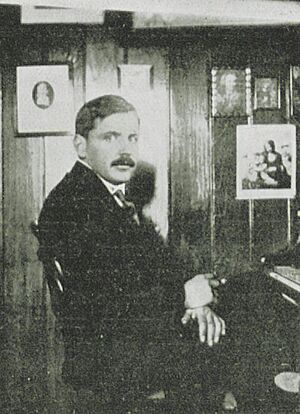Othmar Schoeck facts for kids
Othmar Schoeck (born September 1, 1886 – died March 8, 1957) was a Swiss composer and conductor. He is known for his beautiful classical music. Schoeck wrote many art songs, which are songs for a singer and piano. He also created several operas, which are plays set to music. One of his most famous operas is Penthesilea. It was first performed in 1927 and brought back to the stage in 1999. Besides songs and operas, he also composed music for instruments, like pieces for string quartets and concertos for violin, cello, and horn.
Contents
Biography
Early Life and Music Career
Othmar Schoeck was born in Brunnen, Switzerland. His father, Alfred Schoeck, was a landscape painter. When Othmar was young, he thought about becoming a painter too. He even went to art school in Zurich. However, he soon decided to follow his passion for music instead. He then studied at the Zürich Conservatory.
During World War I, Schoeck worked in Zurich. He directed choirs and played piano for other musicians. From 1916, a kind industrialist named Werner Reinhart gave him money every year. This help, along with his job as a conductor for the St. Gall Symphony orchestra from 1917, allowed Schoeck to spend more time composing his own music.
Meeting Ferruccio Busoni
In 1916, Schoeck met Ferruccio Busoni, another important composer. Busoni had moved to Zurich from Berlin to avoid the war. Zurich became a popular place for artists during this time because Switzerland was neutral. Schoeck really liked the songs of composer Hugo Wolf, but Busoni did not. Even with different tastes, they became good friends and respected each other.
Busoni even suggested that Schoeck create an opera based on a story called Don Ranudo de Colibrados. Later, in 1917, Busoni got a book of Chinese ghost and love stories. He thought one of these stories would make a good opera. Busoni quickly wrote a short opera story called Das Wandbild (The Picture on the Wall). He offered it to Schoeck in 1918. Schoeck accepted the challenge! He quickly composed the music for this new opera in just three days.
Das Wandbild is set in an antique shop in Paris around 1830. A student named Novalis sees a picture of a girl on the wall and is fascinated by it. The picture magically comes to life! The scene then changes to a fantastical Chinese temple. The opera ends with Novalis waking up from his dream and leaving the shop. It is one of Schoeck's most unusual and unique works.
Changes in His Music Style
Around 1918, Othmar Schoeck's music started to change. He became close with a pianist named Mary de Senger, and she seemed to inspire his new musical ideas. His next opera, Venus (composed between 1919 and 1921), used interesting new sounds. For example, it had different rhythms playing at the same time and used two different musical keys at once.
As he learned about new music from composers like Alban Berg and a group called Les six in Paris, Schoeck began to feel that his own music was a bit old-fashioned. In 1922, Busoni, who was back in Berlin, wrote that Schoeck needed to find new ways to create his music.
In the summer of 1923, Schoeck visited composer Arthur Honegger in Paris. He also went to a music festival in Salzburg. Not long after, his relationship with Mary de Senger ended. This breakup, along with the exciting new music he heard, seemed to make his composing style more mature. Just two weeks after the breakup, he wrote a song called Die Entschwundene (The Vanished One). This song was like a goodbye to his old musical style, as well as to his lost love.
Schoeck was not always good at showing thanks, but he dedicated some of his works to Werner Reinhart. These included the song cycle Gaselen (1923) and the Sonata for Bass Clarinet and Piano (1927–28).
Later in his life, Schoeck worked with a German poet named Hermann Burte on an opera called Das Schloss Dürande. This opera was performed in Berlin in 1943. This caused some problems for Schoeck in Switzerland. People were upset because he worked with artists from Nazi Germany. Even though Schoeck himself did not support the Nazis, this situation hurt his reputation and caused him a lot of stress. He had a heart attack in 1944 but continued to compose music.
Compositions
See also
 In Spanish: Othmar Schoeck para niños
In Spanish: Othmar Schoeck para niños


